Is the selenelion lunar eclipse really rare event?
In this text, I would like somewhat to continue the thread from the previous one, which has described briefly my observation of the “just” partial lunar eclipse on Monday morning of May 16th. As I mentioned there, there is a thing, which requires an explanation. The question has been asked in the title and my goal is to answer it right here!
- WHAT IS SELENELION?
Selenelion or Selenehelion is the moment when the lunar eclipse can be observed in daylight. “Selene” in Greek means Moon, and “Helion” refers specifically to the Sun as the primary body about which the planets are orbiting. Otherworldly it’s the horizontal lunar eclipse. A situation such as this can occur just before sunset or shortly after sunrise or at least when the time of sunrise overlaps with the moonset. Both the Sun and the eclipsed Moon lie almost or completely on the horizon at nearly opposite points of the sky (Artley, 2014). In fact, this moment is not observable along with every lunar eclipse, therefore can be treated as some kind of “special extra event”, but is it a really rare event?
Many articles on the web and in newspapers usually try to draw as much attention as they can by describing the selenelion as, for example, “extremely rare opportunity“, “extremely rare event” or “rare selenelion“, “geometrically impossible“, “impossible lunar eclipse” and even that the event such as this “technically should not be able to happen“. The truth is completely different! Selenelion is NOT an extremely rare event, and in fact, is an inherent element of each total lunar eclipse. However, its conditions are various across every particular lunar eclipse event and depend on several factors listed below. On the contrary, a lot of publishers on the web describe just one of them – atmospheric refraction.
2. WHAT CAUSES THE SELENELION?
The selenelion lunar eclipse is possible because of:
A. Atmospheric refraction – the most common factor described widely on the web. Light travels in a straight line, but only in a vacuum or medium with a constant refractive index. Since a light beam enters the Earth’s atmosphere it tends to be bent towards the Earth’s surface due to gradual changes in the density of the medium. Finally, when the celestial body is on the horizon, the refraction lifts it up about 35′. Astronomical objects appear higher in the sky than their actual geometric position therefore both can be visible above the horizon for some time.
As a result of refraction, the eclipsed Moon is about 35′ lower than where it appears. Exactly the same thing happens in the Sun located on the opposite side of the sky.
B. Geometry – For the sake of simplification it’s accepted, that when we have a lunar eclipse, the Sun, Earth, and Moon are in a geometrically straight line in space, with the Earth in the middle. In the practical sense, when the Sun is above the horizon, the Moon must be below the horizon and completely out of sight. In reality, a situation like this happens only very occasionally and indeed, it can be treated as an “extremely rare event”. The syzygy between the Sun, Earth, and Moon is mostly just an approximate alignment. In fact, it can be also perfect, although it happens very, very rarely (Pic. 2, 3).

Pic. 2 The example of the most aligned total lunar eclipses to the ecliptic line ever (at least between 1999BC and 3000AD), which shows the nearest 4 out of 12 examples with the gamma value equal to or smaller than 0.001(Eclipsewise.com).
The level of alignment (or how precise the syzygy is) is determined by the gamma value, which describes how centrally the Shadow of the Earth hits the Moon. When the value is 0, it means, that the shadow cone extends centrally to the center of the Moon. In other words, we have a perfect alignment between Sun, Earth, and Moon, thereby the Sun is roughly at an angular distance of 180º from the Moon and vice versa. In the span of five millenniums of lunar eclipses, there is no eclipse with a gamma value equal to 0! Therefore the perfect syzygy occurrence is not possible! (at least within the considered period). For the sake of simplification, I’ve rounded the perfect alignment between the Sun, Earth, and Moon to a gamma value up to 0.001. Admittedly, we can find just 12 lunar eclipses! The most aligned occurred on August 29th 611AD with gamma -0.0001. The 4 eclipses shown above (Pic. 2) have been bounded red in the captured table below (Pic. 3).

Pic. 3 The list of almost perfectly aligned total lunar eclipses between BC1999 and AD3000 with gamma values up to 0.001 (based on Eclipsewise.com).
According to “Six Millenium Catalog of Lunar Eclipses -2999 to 3000 (2999 BCE to 3000 CE)” we had another 4 most central lunar eclipses, which occurred accordingly on January 24th 2959BC (gamma -0,001), May 3rd 2713BC (gamma 0,0001), September 20th 2460BC (gamma -0,0001) and January 14th 2391BC (gamma 0,0006). Concluding in the span of 6 thousand years we have no lunar eclipse with a gamma value equal to 0, only 3 lunar eclipse which features a gamma value of 0,0001 or -0,0001, and just 16 lunar eclipses with an absolute gamma value of 0.001 or smaller.
That’s why most sources deem syzygy as the perfect alignment rather than just approximate. From the geometrical point of view, the perfect alignment would have happened by the Gamma value equal to exactly 0.
Another important thing is, that the Earth’s umbra is bigger than the Moon. The maximum celestial radius of Earth’s umbra is 0° 45′ 57.6″(Meeus, 1997), but taking into account more typical values we could stick more to 0° 45′ 28.8″, as occurred during the last total lunar eclipse of May 16th, 2022 (Pic. 4). A quite typical angular diameter of penumbra is 1° 17′ 7.44″, although the penumbral lunar eclipse is not considered that much as the selenelion in general.
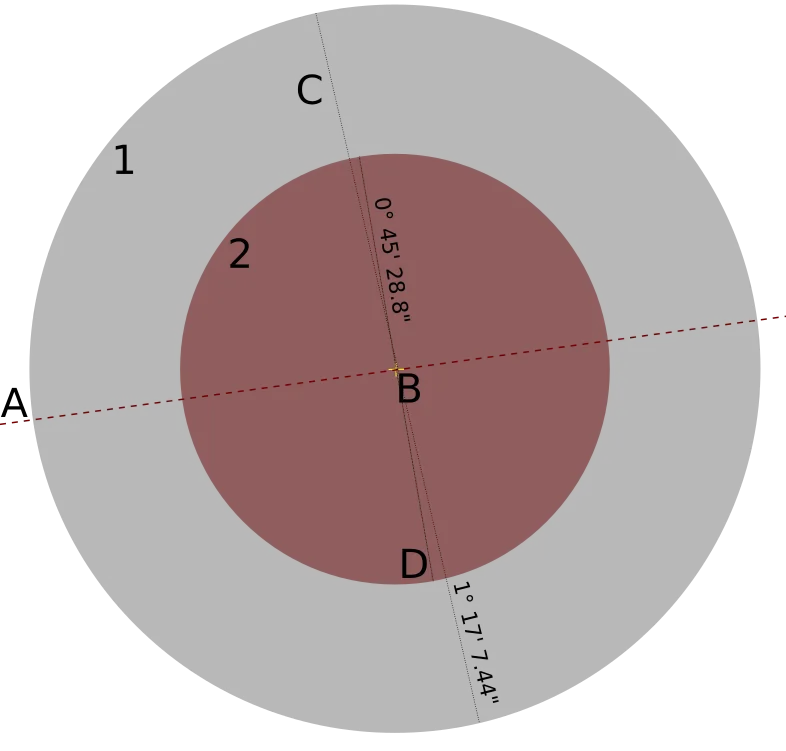
Pic. 4 The size of Earth’s umbra and penumbra as observed during the May 16th, 2022 total lunar eclipse.
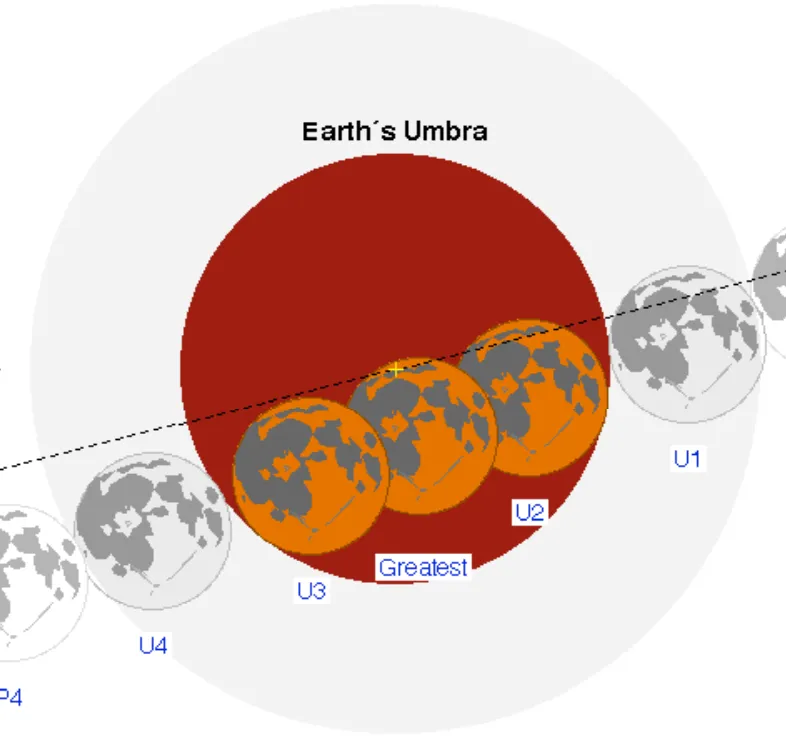
Pic. 5 The example of the random lunar eclipse, where the center of the Moon passes the ecliptic from the south during the totality (eclipse.gsfc.nasa.gov).
Since the biggest celestial radius of Earth’s umbra is 0° 45′ 57.6″ it clearly means, that it reaches the maximum absolute ecliptic latitude of the same value. Because the angular diameter of the Moon is between 29 and 33′ as mentioned in this article, we can see the fully eclipsed Moon, which upper edge will have about – 0° 16′ in the worst-case scenario. Even in a situation such as this, selenelion is possible because of the aforementioned refraction (Pic. 6).
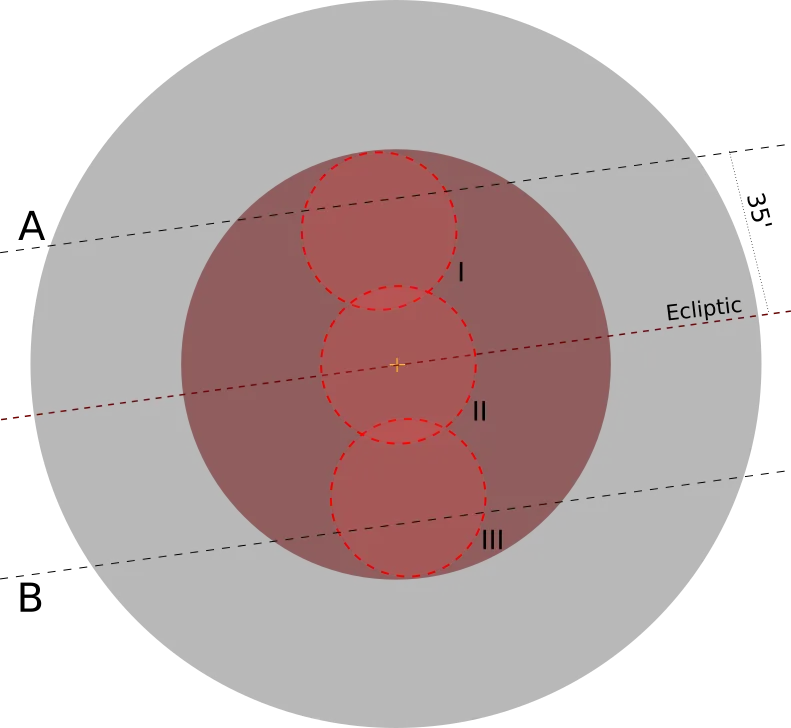
Pic. 6 Total lunar eclipse pattern against atmospheric refraction at the moment of astronomical sunrise. Even in the most unfavorable geometric conditions, the selenelion lunar eclipse seems to be possible. A – apparent horizon in the southern hemisphere; B – apparent horizon in the northern hemisphere. Both are around 35′ beneath the astronomical horizon.
Obviously, we treat the selenelion lunar eclipse as the moment when both at least the upper Sun’s and Moon’s disks are visible above the Horizon. As the image above shows in each case, the event is possible, because even if the Moon is just placed inside the umbra (case I or III) with its upper disk pulled around 16′ away from the ecliptic, it’s still visible at the moment of sunrise, which must be treated as the astronomical sunrise. If we could assume the false sunrise was caused by refraction, we should have multiplied the angular distance between the ecliptic and points A or B by 2 and get 70′ instead of 35′. This approach leads to the conclusion, that at the moment when false sunrise starts to occur (or false sunset finishes), we have the whole umbra visible above the horizon! Admittedly this is the shortest event possible, which lasts just over 2 minutes. Its length is driven by the time needed for the Sun of the moon to rise/set in a whole disk behind the horizon. When the eclipse has a central character, the eclipsed Moon is fully visible above the horizon at sunrise.
C. High elevation – almost always guarantees a clear horizon for both sides towards the solar and antisolar direction. Moreover, the horizon dip caused by our elevated position against the area means, that all celestial bodies are visible longer in the sky than they could be because the apparent horizon lies below the astronomical one. In turn, a depressed horizon gives always the best conditions for the selenelion lunar eclipse observation despite other elements described here. Concluding, mountain tops are always good spots for watching the rising Sun and eclipsed Moon above the horizon simultaneously (Pic. 7).

Pic. 7 The decent example of lunar selenelion, which was possible to catch at the summit of Lomnica Peak (Lomnický štít) in the High Tatras (Vysoké Tatry). The horizon depression is about 1,5 degrees on average. The circumstances set at 4:50 UTC+2 on May 16th, 2022, when a partial lunar eclipse took place at that location show the Sun already shining yet below the astronomical horizon, whereas the eclipsed Moon is still about to set behind the astronomical horizon at the antisolar direction (Peakfinder.org).
At relatively high summits, the lunar selenelion is possible to observe at every possible lunar eclipse, because of the horizon dip. The example above presents the local circumstances for the Lomnica Peak (Lomnický štít) in the High Tatras (Vysoké Tatry) at the local time of 4:50 UTC+2 on May 16th, 2022, when the partial lunar eclipse occurred. We can clearly see the Sun rising above over a 1.5-degree depressed horizon, which normally would have another at least 2-3 minutes to come out. This is a false sunrise event, which occurs when the Sun rises above the visible horizon, but it’s still beneath the astronomical horizon defined by the given location. The same applies to the Moon. It’s applicable not solely for the horizon depression but also for the atmospheric refraction circumstances described above. In the opposite direction, the eclipsed Moon is about to set behind the Gerlach summit (Gerlachovský štít), which reaches the astronomical horizon at this azimuth. Our natural satellite still has around 2 minutes to be plunged behind this peak and another 5 minutes to disappear below the visible horizon completely. As a result, the selenelion from Lomnica Peak (Lomnický štít) could last up to 15 minutes. Refraction is included, but even when excluded, the event could be fairly possible.
D. Lunar location against the mid-eclipse point – it’s fairly not less important thing than the geometry. Previously I described the situation, which is typical for the around mid-eclipse moment. Now I would like to focus on the moment of the lunar disk’s disappearance behind the Earth’s umbra. In a practical sense, the selenelion lunar eclipse is rather visible by the not fully eclipsed Moon. The piece of lunar disk outside of Earth’s shadow is bright enough to be visible in the sky almost fully illuminated by the Sun. In fact, the moment when Moon goes behind the Earth’s umbra completely (U2) or emerges from it (U3) has its own ecliptic latitude, which can be favourable for the observer or not (Pic. 8).
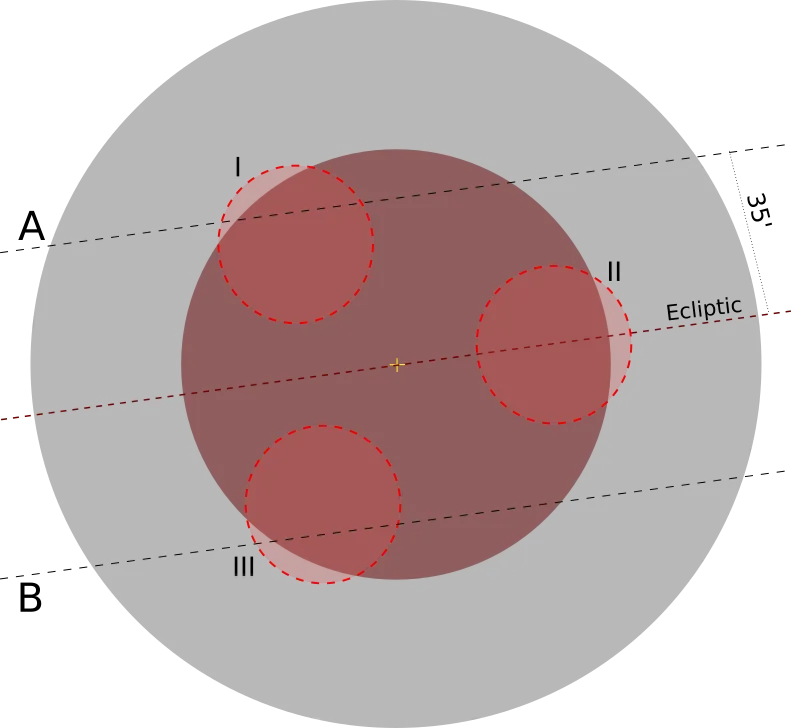
Pic. 8 Deep partial lunar eclipse pattern against atmospheric refraction at the moment of astronomical sunrise. Before the U2 or after the U3 moments some piece of the lunar disk is visible in the sky. Its disappearance behind the Earth’s umbra has its own ecliptic latitude. Even in the most unfavorable geometric conditions, the selenelion lunar eclipse seems to be possible. A – apparent horizon in the southern hemisphere; B – apparent horizon in the northern hemisphere. Both are around 35′ beneath the astronomical horizon.
The principle here is the same, although the ecliptic latitude changes across the period of the eclipse, because the Moon is in motion, therefore it changes its declination. The direction of these changes is determined by the placement of the nodes. Because of these changes, it’s impossible to get the same ecliptic latitude for the U2, mid-eclipse, and U3 moments (Pic. 2,5,8). However, the ecliptic latitude of U2 or U3 will never exceed the most extreme latitude of Earth’s umbra. This is an exception from this dependency. If the lunar eclipse is observed at lower latitudes by the eclipse season located close to the equinoxes, we have experienced situation II in the image above (Pic. 6). In this case, the selenelion lunar eclipse can be extended because our point of reference won’t be ecliptic, but the geometrical antisolar point in the center of the Earth’s umbra. In this case, when the Moon is just partially eclipsed before U2 or after U3, the horizontal lunar eclipse can advance of penumbra limit (1° 17′ 7.44″). Because the angular “thickness” of the penumbra is about 31′, which is pretty much corresponds to the angular diameter of the Moon. This is just a far-reaching assumption because the selenelion lunar eclipse refers to the total phase only, which indeed is rather not visible in daylight conditions, hence an observer always needs some part of the Moon to be bright enough for watching. It will surely exceed the angular radius of umbra when the point II (Pic. 6) is taken into account. In conclusion, the selenelion lunar eclipse just before U2 and after U3 conditions are usually better to observe and improve as we move towards equatorial latitudes.
3. SELENELION’S APPEARANCE AGAINST THE BELT OF VENUS AND EARTH’S SHADOW
The Belt of Venus is a beautiful, although subtle atmospheric phenomenon, which occurs shortly before sunrise and after sunset (Pic. 9).
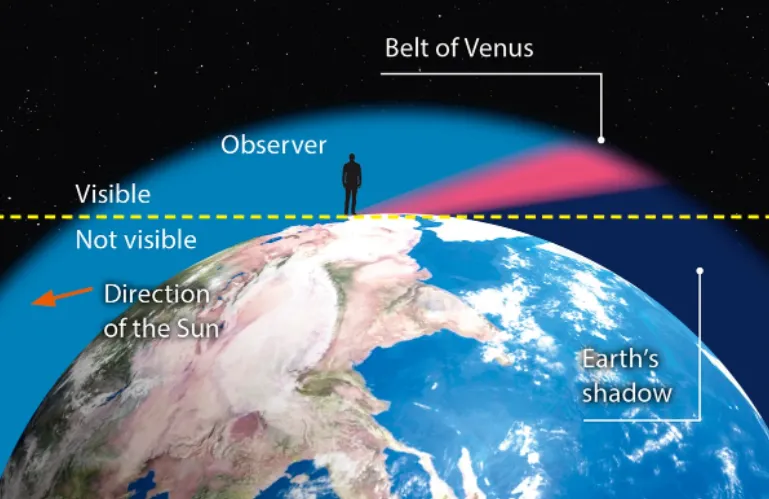
Pic. 9 The Belt of Venus occurrence pattern (SkyAtNightmagazine.com).
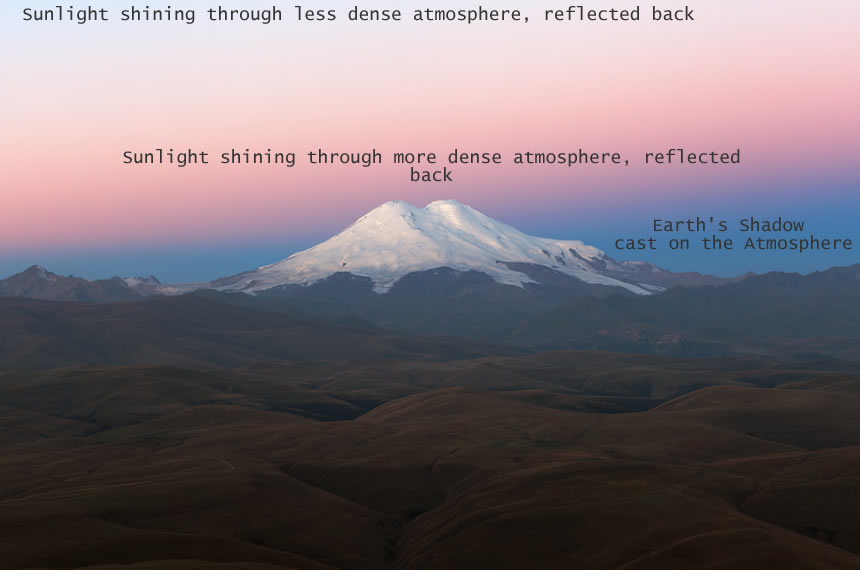
Pic. 10 Visual interpretation of the Belt of Venus (Phenomena.org).
It’s a result of the backscatter of reddened sunlight, which produces the rosy arch shining in the stratosphere (being more precise around the ozonosphere). Otherworldly it reflects the sunset as seen around 35km above ground, where the horizontal depression reaches 6º. In fact, the phenomenon has been partially described in this article, but I will explain it widely in the future. The Belt of Venus separates the illuminated Earth’s atmosphere from shadowed by the Earth itself (twilight wedge). Between them two, especially near sunrise and sunset we can spot the dark segment, which is a result of the greatly reduced amount of sunlight passing through the atmosphere close to the Earth’s surface. This dark segment looking like a dark bluish rim is a transition between the Belt of Venus and Earth’s shadow beneath. It’s a result of shadow, which Earth’s atmosphere casts by itself (Lynch, Livingston, 2001). The shadow boundary appears sharper from high elevations. The sharpness of the twilight wedge changes rapidly and depends strongly on the position of the Sun below the horizon. As the Sun goes deeper beneath the horizon both the Belt of Venus as well as twilight wedge rises. Finally, the antitwilight arch turns to fade to blue. However, this moment happens far outside of the selenelion lunar eclipse. The essence of the horizontal lunar eclipse occurrence is its position against the Belt of Venus and twilight wedge or alternatively, the atmospheric shadow expressed by the bluish rim described above. The position of the eclipsed Moon here depends on two major factors:
– the placement of the eclipsed Moon against the ecliptic (described earlier), which impacts its final position in contrast to the Sun
– the time of observation versus sunrise or sunset regardless of the depression of the local horizon.

Pic. 11 The graphic explanation of the selenelion lunar eclipse versus false sunrise and appearance of the Belf of Venus and twilight wedge, where: A – astronomical horizon at the solar direction, B – astronomical horizon at the antisolar direction, A’ – apparent horizon at the solar direction, B’ – apparent horizon at the antisolar direction, O – observation venue, Z – zenith, a – ideally straight line between the Sun and ecliptic at the antisolar direction, b – angular difference between antisolar direction and upper boundary of Earth’s shadow and Belt of Venus; 1 – 3 the moments between false sunrise and true sunrise at an elevated place.

Pic. 12 The animation of the twilight wedge and selenelion lunar eclipse behavior on the contrary of the rising sun.
The horizon dip is not important that much in the relationship between the horizontal lunar eclipse and the appearance of the twilight wedge since the primary determinant is the ecliptic latitude of the Moon itself. However, if our observation place is located in the highlands, the whole phenomenon is much better visible because we can experience longer false sunrise/sunset. The image and animation above describe clearly what happens when a total lunar eclipse occurs at positive ecliptic latitude in the northern hemisphere. Despite atmospheric refraction, the Moon would be visible above the horizon roughly at sunrise or sunset. In this particular case, its position corresponds to the lower part of the Belt of Venus, which fades towards a grey-bluish appearance because of the atmospheric shading. For the sake of simplification, we can assume, that the selenelion lunar eclipse takes place within the antitwilight arch at the moment of sunrise/sunset. Despite a positive ecliptic latitude of the Moon, this situation is no longer applicable when considering the Sun shining from below the astronomical horizon, which usually occurs at mountain summits, etc. Because the position of both the shadow of Earth and the Belt of Venus is firmly reliant on the position of the Sun against the horizon, we should expect to see the selenelion lunar eclipse mostly inside of the twilight wedge despite the visibility of the Sun. It does happen just on highly elevated grounds unlike the lowlands, where the Sun won’t be visible yet. In order to understand what it looks like, I prepared 2 images below. The first one shows the selenelion lunar eclipse on April 4th, 2015 captured from Joshua Tree National Park, where the Moon despite its relatively high ecliptic latitude is still visible inside the Earth’s shadow

Pic. 13 The example of a selenelion lunar eclipse, which was observed from Joshua Tree National Park, CA where during the false sunrise, the eclipsed Moon is still plunged inside the twilight wedge (Jörg Shoppmeyer/Vimeo.com). Below are the 4.04.2015 total lunar eclipse circumstances (eclipse.gsfc.nasa.gov).

Pic. 5 The selenelion lunar eclipse seen from Haleakala Observatory, HI where the Sun is high enough to let the eclipsed Moon be visible inside of the Belt of Venus (Rob Ratkowski/Epod.usra.edu). Below are the 21.01.2019 total lunar eclipse circumstances (Eclipse.gsfc.nasa.gov).

Pic. 14 The comparison of two selenelion lunar eclipses against the position of the Sun and Moon with respect to the astronomical horizon. The blue line marks the astronomical horizon, red lines indicate the fuzzy border between the twilight wedge and the Belt of Venus. Once the Sun shines below the astronomical horizon, the horizontal lunar eclipse is observed inside of the twilight wedge (Left: Rob Ratkowski/Epod.usra.edu; Right: Joerg Schoppmeyer/Vimeo.com).
The other image comes from Hawaii, where the eclipsed Moon was observed also with the rising Sun, but the image was taken when the Sun crossed the astronomical azimuth. In turn, the selenelion lunar eclipse is visible inside the Belt of Venus. The twilight wedge is almost gone, we can see just a bluish rim produced by the shadow of the Earth’s atmosphere.
Let’s consider the key factor, mentioned earlier, which is the ecliptic latitude of the eclipsed Moon. When it’s positive for the given hemisphere (+ for northern and – for southern accordingly), then the selenelion will be visible within the Belt of Venus (or just the shadow of the atmosphere) at the moment of true sunrise/sunset despite the altitude. When it’s negative (- for northern and + for southern accordingly), the horizontal lunar eclipse will be visible inside of the Earth’s shadow at the moment of true sunrise. It also means that the altitude of the observation will be crucial here because it will determine the visibility of the Moon or not. Refraction in fact will help here, but not that much if the Moon will pass the southernmost part of the shadow.

Pic. 15 The relation between the horizontal lunar eclipse and its ecliptic latitude in relation to the exemplar total lunar eclipses (eclipse.gsfc.nasa.gov).
Translating the pattern above (Pic. 15) to the situation below, we can clearly see the difference. The images were captured at a similar time before the moonset. The left one clearly shows the selenelion lunar eclipse occurring within the Belt of Venus fading toward the shadow of Earth’s atmosphere. The right one displays a similar position of the Moon but inside of the Earth’s shadow (dark bluish background).

Pic. 16 The eclipsed moonset against the Belt of Venus occurrence. The images show the eclipsed moonset occurring under different geometrical conditions. On the left the lunar eclipse ends just after astronomical sunrise, therefore it’s inside the Belt of Venus (8.10.2014). On the right, an analog position of the eclipsed Moon takes place just before sunrise, so it’s inside the twilight wedge, beneath the Belt of Venus (16.05.2022) (Left: Wikimedia.com/Right: Radek Grochowski-Spaceweathergallery.com).
3. SELENELION VERSUS PARTIAL OR PENUMBRAL LUNAR ECLIPSE
Selenelion lunar eclipse can be observed only when a total lunar eclipse takes place. The essence of the selenelion is an ideal alignment between the Sun, Earth, and Moon, where the angular distance between the Sun and eclipsed Moon is roughly 180º. It never happens, as it was found earlier. We need to apply some approximations here, which also have been discussed before. Only Earth’s umbra points out a rough or approximate antisolar direction. It doesn’t apply to the penumbra, which encircles the umbra at an angular distance of at least 45′ from the antisolar point. The answer is simply tough. A partial lunar eclipse means, that some part of the lunar disk remains outside of the umbra. Even if the eclipse magnitude is close to 1, the Moon is still about 16′ out of the geometrical antisolar point. Therefore partial lunar eclipse has no moment of selenelion because the Moon never reaches the proper antisolar point.
In the case of the penumbral lunar eclipse, the Moon can be aligned to the Sun as much as 179º, thus there is no way for selenelion occurrence. Even the deepest penumbral lunar eclipse will mean, that the Moon is at least 45′ away from the geometrical antisolar point (Pic. 4).
4. WHEN THE SELENELION LUNAR ECLIPSE IS IMPOSSIBLE TO SEE?
It has been explained, that the selenelion lunar eclipse occurs during every total lunar eclipse. It works, of course, but just in a pure geometrical sense. Why we cannot see the selenelion during every total lunar eclipse explain 2 crucial factors listed below:
– the apparent brightness of a totally eclipsed Moon – is really small when compared to the full Moon of even a partially eclipsed one, which is clearly understandable. It was found, that the mean stellar magnitude of a fully eclipsed Moon is -0,6 Mag (Westfall, Sheehan, 2015). However, it can vary between +4.1 Mag to even -4 Mag depending on eclipse magnitude and Danjon scale. This range of magnitudes except for the brightest ones is rather impossible to spot in daylight. On top of that, when the Sun is above the horizon, the eclipsed Moon is very low or even on the horizon. In this case, along with the sky’s surface brightness also atmospheric extinction takes place. Both factors make the visibility conditions of the eclipsed Moon very restricted.
– local topography – it does happen quite often when the distant horizon is higher than our observation place. In a case like this, the sunrise will occur later than it should, and accordingly, the moonset will happen earlier than estimated. A good example comes from the last partial lunar eclipse observed in Poland, when a moonset was observed a few minutes before sunrise despite the local ephemeris (Pic. 13, 14). In turn, instead of selenelion, we have the period of time, when both no Sun and no Moon are visible in the sky when they should be. Every distant horizon has its own angular altitude. When everything is completely flat, like we have somewhere on the sea, then all factors described earlier all applicable: geometry, refraction, and so forth. When we have some inland location, the distant horizon rather won’t coincide with the astronomical one. It will have some angular altitude, which will make the celestial bodies invisible beneath it. This is a particular case, of non-selenelion occurrence, which in fact doesn’t exist in the astronomical sense. This is also the reason, why some elevated locations with clear horizons are recommended for observations such as this. Any elevation means, that the angular altitude of the remote horizon is reduced, making celestial bodies visible for a longer time.

Pic. 13 The Last partial lunar eclipse as seen from the Cold Water (Zimna Woda) village in southeastern Poland has rounded off also the moment of selenelion lunar eclipse between 4:47 and 4:49 UTC+2 but it was invisible due to local topography. Both images were captured at 4:46 UTC+2 local time. It was about 1 minute to astronomical sunrise and 3 minutes after the eclipsed Moon was gone completely.

Pic. 14 The optics of the atmosphere about 1 minute before astronomical sunrise. Twilight wedge is almost gone, but due to the hazy atmosphere, it casts a shadow by itself making the Belt of Venus bluish appearance at the bottom.
The image above shows the visible discrepancy between the topography and the current celestial situation. The shadow cast by the atmosphere and twilight wedge is high enough to deem, that sunrise hasn’t occurred yet. As it has been told earlier, at astronomical sunrise the twilight wedge should be gone and the other shadow produced by the Earth’s atmosphere should be significantly reduced by the Belt of Venus above. I promise to explain it more widely in the future.
4. CONCLUSIONS
Selenelion is in general, a quite elusive phenomenon, which lasts just up to 6 minutes in typical conditions. During unfavorable geometric conditions, Selenelion might occur even if the Moon remains visible inside of the receding Earth’s shadow, beneath the Belt of Venus, which is a coincidence with the astronomical horizon meaning sunrise at the given location. In the most favorable conditions, where all the factors have a positive influence, the selenelion might be observed over 20 minutes! Despite the fact, that selenelion is a popular moment of a total lunar eclipse it can happen only at a specific place and time during the progression of the eclipse. Anyhow, the selenelion is a must-see occurrence for any observer, whose location allows for it. Quite often, however, people are unable to see the Sun and fully eclipsed Moon at once, especially because of the local topography circumstances. Because of this situation combined with the small brightness of the fully eclipsed Moon, it’s commonly believed that selenelion is an “extremely rare” phenomenon. It’s not true, because all the elements described in this text state, that this occurrence is an inherent moment of every total lunar eclipse restricted by the moment of moonset. On the other hand, the total lunar eclipse is only one type of lunar eclipse, which can provide the selenelion occurrence. This is driven by geometry, which places the Earth exactly between the Sun and the Moon.
Mariusz Krukar
References:
- Artley M.N., 2014, The Full Moons: Topical Letters In Esoteric Astrology, EbookIt.com
- Espenak F., Meeus J., 2021, Five Millennium Canon of Lunar Eclipses, Astropixels Publishing, Portal, AZ.
- Lynch D.K., Livingston W.C., 2001, Color and light in nature, Cambridge University Press, Cambridge.
- Meeus J., 1997, Mathematical astronomy morsels, Willmann-Bell Inc., Richmond
- Westfall J., Sheehan W., 2015, Celestial shadows – eclipses, transits and occultations, Springer, New York, Heidelberg, Dordrecht, London
Links:
- https://www.astronomyclub.xyz/solar-eclipse-2/the-selenelion-or-horizontal-lunar-eclipse.html
- https://flatearth.ws/selenelion
- https://www.pinterest.co.uk/pin/382524562076370102/
- https://epod.usra.edu/blog/2019/02/selenehelion.html
- Selenehelion 27.07.2018
- Lunar eclipse observations during daylight
- https://www.space.com/27338-total-lunar-eclipse-rare-sunrise-selenelion.html
- https://san-francisco-hostel.com/event/selenhelion-the-baddest-ass-lunar-eclipse-ever
- https://www.ibtimes.co.uk/extremely-rare-selenelion-take-place-during-total-lunar-eclipse-watch-live-online-1468739
- https://www.phoenixnewtimes.com/arts/when-to-catch-tomorrows-impossible-total-lunar-eclipse-6568638
- Syzygy – definition
- https://www.the-spaceship.com/lunar-eclipse/
- https://www.stuff.co.nz/science/105801554/what-on-earth-is-a-selenelion-heres-what-you-need-to-know-about-eclipses
- Selenelion lunar eclipse of October 8, 2014
- https://gruposaedal.com/how-to-watch-a-total-eclipse-of-the-moon-astronomy-essentials/
- Eclipsewise.com: 5 millennium’s catalog of lunar eclipses between 1999 BD and 3000 AD
- https://eclipse.gsfc.nasa.gov/lunar.html
- https://upscquiz.com/2022/05/13/there-is-a-total-lunar-eclipse-this-weekend-heres-how-to-watch-it/
- Space.com: Information about the October 8th, 2014 total lunar eclipse
- https://earthsky.org/astronomy-essentials/how-do-i-watch-the-total-lunar-eclipse/
- https://scitechc.com/skywatching/total-lunar-eclipse-on-wednesday-is-a-rare-selenelion/
- https://www.ibtimes.co.uk/extremely-rare-selenelion-take-place-during-total-lunar-eclipse-watch-live-online-1468739
- https://www.morefm.co.nz/home/trending/2018/07/extremely-rare–selenelion–eclipse-to-be-seen-in-south-island-s.html
- https://www.phoenixnewtimes.com/arts/when-to-catch-tomorrows-impossible-total-lunar-eclipse-6568638
- https://astro.nz/blogs/entry/12-lunar-eclipses-and-selenelions/
- https://www.sciencealert.com/this-complete-guide-to-this-weekend-s-total-lunar-eclipse
- https://www.space.com/13856-total-lunar-eclipse-rare-senelion.html
- In search of selenelion
- https://www.businessinsider.com/special-oct-8-lunar-eclipse-is-selenelion-2014-10?IR=T
- https://epod.usra.edu/blog/2019/02/selenehelion.html
- Selenehelion 27th of July, 2018 – atmospheric refraction explanation
- https://www.skyatnightmagazine.com/advice/belt-of-venus/
- https://www.phenomena.org/atmospheric/beltofvenus/
- https://www.britannica.com/science/helion
- Eclipsewise.com: 5-millennium catalog of lunar eclipses
- Eclipsewise.com: 6-millennium catalog of lunar eclipses -2999 – 3000
Forums:
Wiki:
Videos:


